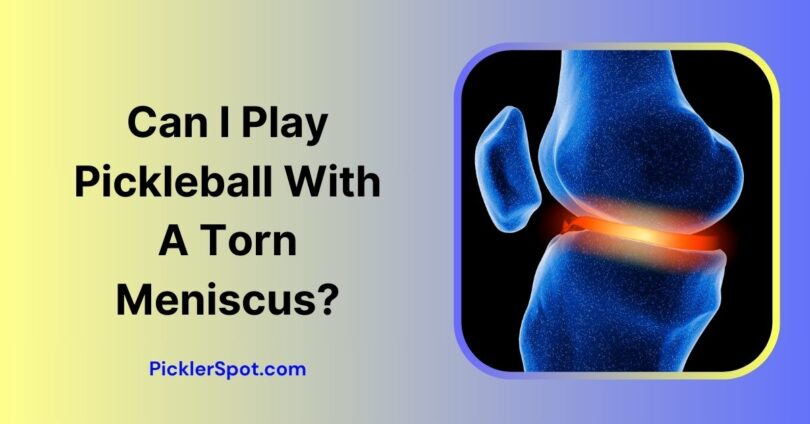In the Pickleball court where anything is possible at any moment, I have seen tons of players perform moves that can act as a potential health hazard.
It’s perfectly understandable that pickleball is more about showing finesse and keeping the spectacle entertained but it should never be at the expense of your health by pushing your limits when you aren’t supposed to.
Since footwork is paramount, injuries like the meniscus being torn can arise pretty quickly, and surprisingly enough it’s so common that I have seen players saying “ Can I Play Pickleball With A Torn Meniscus”.
Well, to address such a tacky situation let’s find out what exactly is Meniscus and how it could get injured.
What Is Meniscus And How Does It Get Torn?
If you have ever driven a car on a rough patchy road, you would know that no matter how uneven the terrain gets, your car shock absorbers compensate for discomfort that the terrain otherwise may cause regardless of the speed you may be traveling.
Similarly, the meniscus, which is a special fibrocartilage present between our tibia and femur resembles a pad-like cushion with a shape that is identical to a crescent moon to distribute the weight of the upper body evenly without causing damage between the joint of the knee.
A meniscus is meant to be slippery and has lubrication to ensure there is minimal friction that may otherwise cause wear and tear while moving from one place to another.
The lubricant is known as synovial fluid which ensures the knee joint doesn’t grind with each other.
So How Does It Get Torn Or Injured?
You might be wondering, after all the seamless operation that corresponds to preventing friction and general wear and tear, how does the meniscus end up getting injured or worn out?
Well, just like every other part of our body, the meniscus also has a limit to endure which when exceeded results in micro tears which then become prominent enough to result in major injury that may ruin the mobility of the knee causing pain and stiffness.
Typically, there are two forms of meniscus,
- Medial meniscus
This is the crescent-shaped meniscus that is present on the inner side of the knee.
- Lateral meniscus
These are the pad-shaped meniscus that is located at the outer edge of the tibia and femur.
Most Common Meniscus Based Injuries
Here are a couple of reasons why such a mishap could possibly happen.
1. Trauma
Trauma or unnecessary force could drastically increase the chances of injuries that may ruin the mobility of your knee. Sports like Pickleball, Squash, and Tennis require plenty of footwork where you are supposed to perform pivoting motions as well as a sudden twist that can take a toll on your meniscus present between your tibia and shinbone.
While most injuries usually recover quickly since the tears produced aren’t too major or significant enough to cause pain or stiffness, the micro tears if not recovered in due time can become a problem eventually.
2. Natural Degeneration
Our body becomes highly vulnerable when it ages over the duration of time and there is no cure that could reverse such damage. While you could exercise to slow down the muscle and connective degeneration process, one way or another your body is going to go through the degenerative process which may exacerbate issues and may result in torn meniscus.
3. Obesity
Regardless of how youthful you may be, even if you are careful, being overweight can result in unwanted wear and tear that could increase the friction between the knees by tenfold. The problem exponentially increases when a person who is overweight or obese tries to lift weight or perform sudden motion which can cause unnecessary trauma to the lower torso.
Obesity also blocks the flow of the blood to the tibia and shinbone region which is why even if micro injuries appear, the slow blood flow may negatively impact the recovery process in the long run.
Can I Play Pickleball With A Torn Meniscus
Now getting to the point on whether or not you could play pickleball with a torn meniscus, in that case, although, as per physicians, doctors, and Pickleball gurus like me, I wouldn’t suggest you put yourself through such strenuous sports when going through such ordeal, however, if you are inclined to play Pickleball since it is so Addictive, there are some minor workarounds.
1. Wear A Brace
The biggest and the most apparent when your meniscus gets torn or gets injured is radiating pain, swelling and even popping which might cause discomfort whenever you are bending the knee.
In that case, in order to minimize the pain and reduce swelling so it could recover properly, wearing a medicated brace could work wonders. You could also wear knee bands that could protect your muscles and keep your knee warm especially during the chilly nights so that you won’t have to rely on medication which may be wrought upon by another form of negative side effects.
On the other hand, wearing a brace could also keep your knee upright preventing unnecessary movement that could otherwise aggravate your injury. On the other hand, it will support proper blood flow for a healthy recovery.
2. Be Mindful Of Your Footwork
Repelling a last-minute lob or Ernie could be deemed fruitful for the team and Oyu may look cool in doing so, however, it may not be healthy for your knee, so make sure your moves are limited, so avoid running around and play as defensively as possible.
Make sure you don’t partake in rallies altogether and announce your position to the opponent so they can ensure the state of the game remains as laid back and slow as possible by keeping the settings recreational only.
3. Avoid Slippery Areas
Although, you shouldn’t be playing in the rain even if you are feeling perfectly fine if you insist on playing on a court that has been dealt with rain, try to avoid areas that are wet. If you are playing indoors make sure you wear proper trainers or shoes with enhanced traction to keep you steady on the floor.
Bottom Line
To conclude this article, I would like to remind you that the above-mentioned workarounds are only meant to be performed once you consult with a healthcare professional or your doctor by allowing them to examine your injury and conclude whether or not you are fit for such strenuous extracurricular activity.
Failure to comply could possibly result in aggravating the injury and may exacerbate the state of your knee which may require surgery. Always wear supportive footwear and braces, to promote healthy knee movement, and use recliners or use stools that may help you in jumpstarting the blood circulation in your feet.









